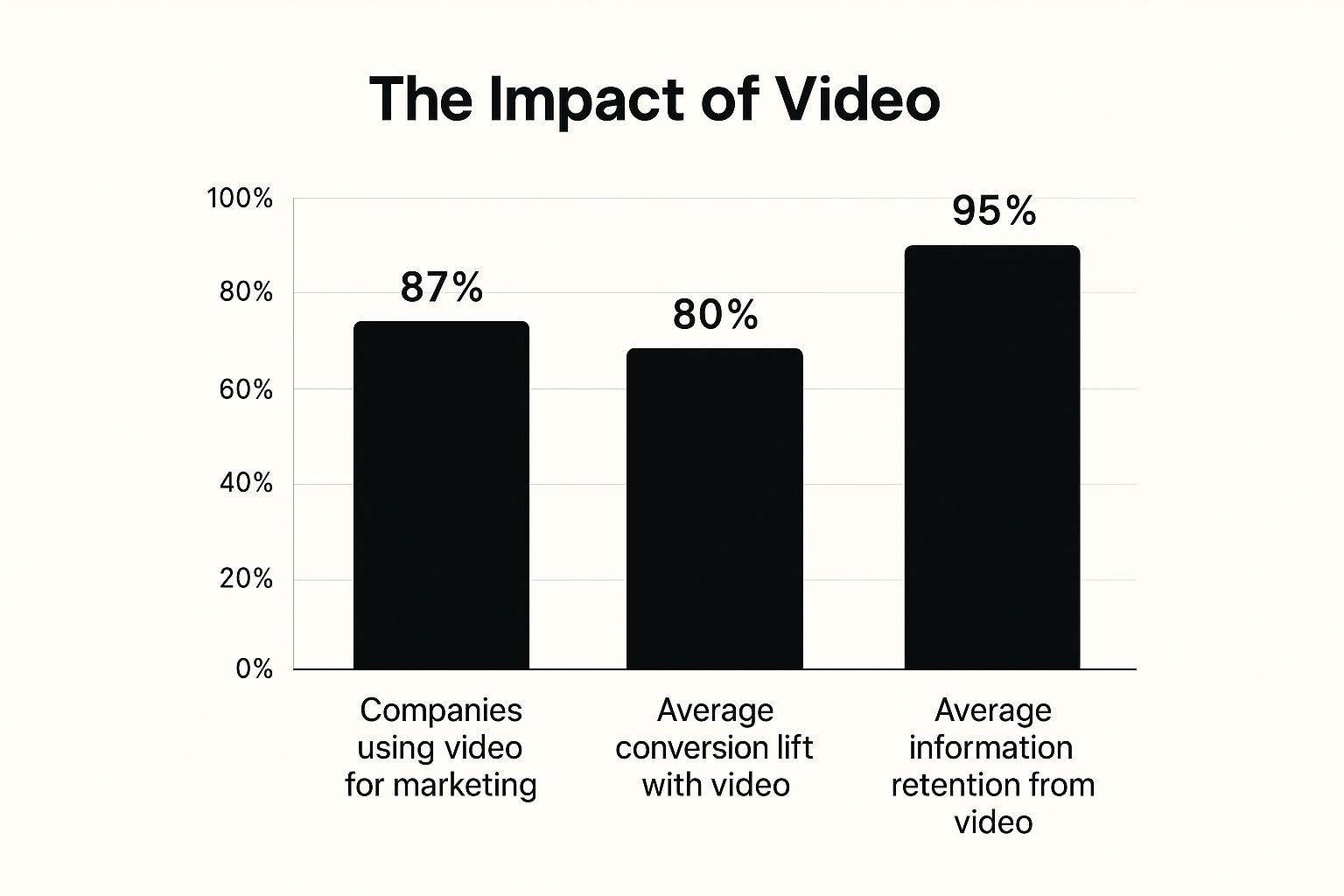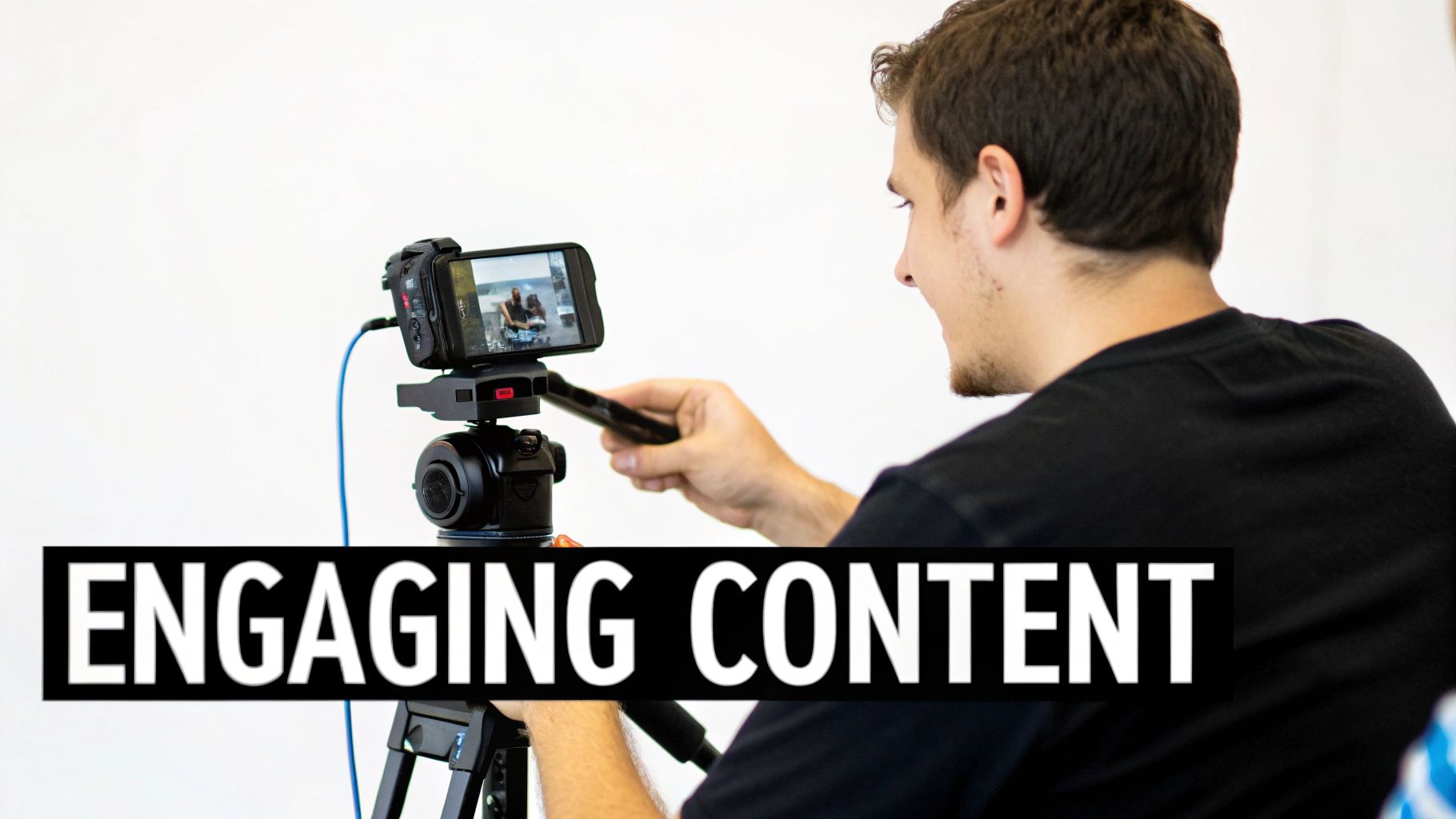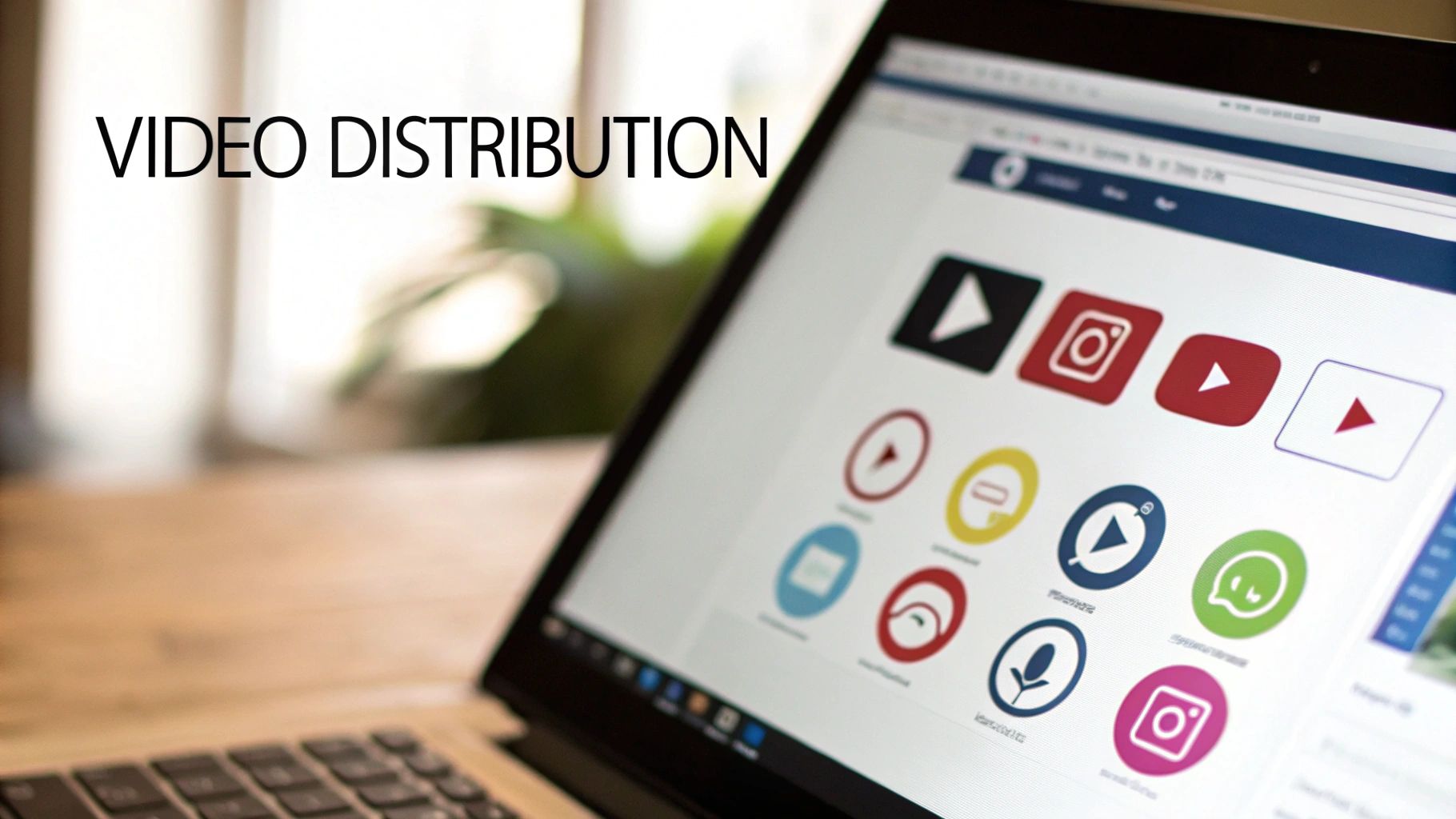
Master video for lead generation with proven strategies that actually work. Discover how successful marketers create videos that convert prospects.
Why Video For Lead Generation Changes Everything
Traditional lead generation tactics like cold calling and email blasts are losing their impact. In today's fast-paced world, businesses need fresh strategies to grab their target audience's attention. Increasingly, that means turning to video. Video marketing offers a dynamic and engaging way to connect with potential customers, presenting a compelling alternative to static content. It's a powerful way to convey complex information quickly and efficiently, keeping viewers hooked in ways that text and images alone simply can't. But what exactly makes video so effective for lead generation?
The Power of Visual Storytelling
A key reason for video’s effectiveness lies in the power of visual storytelling. Humans are inherently drawn to narratives. Video provides a compelling medium for crafting stories that resonate deeply with viewers. A short video showcasing a customer success story, for example, can be significantly more impactful than a written testimonial. Video lets viewers connect with the customer on a personal level, experiencing their emotions and hearing their voice directly. This builds trust and credibility, making the overall message far more persuasive.
Building Trust and Credibility Through Video
Video also offers a unique platform to showcase your brand's personality and values. Authenticity is paramount in today's market. Video allows you to connect with your audience authentically, fostering genuine relationships that can turn into conversions. By offering glimpses into your team, your workspace, or your processes, you create a sense of transparency that strengthens trust with potential customers. This trust directly translates into increased lead generation. People are simply more likely to interact with a brand they see as authentic and relatable. Video for lead generation is becoming increasingly popular among marketers. In fact, projections show that by 2025, 28% of marketers will gauge the success of their video marketing efforts based on the leads and clicks generated. This clearly highlights video's effectiveness in capturing potential customers' attention and guiding them through the sales funnel. The growing popularity of social media platforms further amplifies video's reach, with 53% of video marketers leveraging social media videos to drive traffic to landing pages specifically designed for lead generation. You can explore more detailed statistics on video marketing here: Learn more about video marketing statistics.
Staying Ahead of the Competition
Video's effectiveness isn't solely about capturing attention; it's also about setting your brand apart. In a world saturated with content, video gives you a unique edge over the competition. Interactive elements, personalized messaging, and compelling visuals can transform passive viewers into actively engaged leads. This engagement, in turn, generates invaluable data that businesses can use to refine their marketing strategies and optimize their lead generation efforts even further. Ultimately, video empowers businesses to create experiences that resonate, inform, and convert, pushing the boundaries of what's achievable in today's competitive marketing landscape.
Video Formats That Actually Generate Quality Leads
Choosing the right video format is crucial for successful lead generation. Some formats consistently outperform others, resonating better with prospects and driving higher conversion rates. This ultimately maximizes your return on investment.
Explainer Videos and Product Demonstrations
Explainer videos are highly effective for concisely and engagingly introducing complex products or services. Think of them as your visual elevator pitch. These videos simplify key features and benefits, making them easy for potential customers to understand.
Product demonstrations, conversely, offer a more in-depth view of your product in action. This allows prospects to visualize its value and grasp how it solves their problems. A software company, for instance, might create a product demo showcasing its interface and key features.
Customer Testimonials and Interactive Content
Customer testimonials offer powerful social proof, using the positive experiences of satisfied clients to build trust and credibility. These videos feature real customers sharing their product or service endorsements, creating authentic connections with potential leads.
Interactive content further elevates engagement, allowing viewers to actively participate within the video. Clickable hotspots, quizzes, and branching narratives personalize the viewing experience, capturing valuable lead data and fostering stronger brand connections.

The infographic above highlights the impact of video marketing. It compares the percentage of companies using video, the average conversion lift, and the impressive information retention rate.
A significant 87% of companies utilize video for marketing, experiencing an average 80% conversion lift and a remarkable 95% information retention rate. This data underscores video's power to attract, engage, and convert prospects.
To help illustrate the strengths of various video formats, the table below summarizes their performance regarding lead generation:
Video Format Performance Comparison for Lead Generation
| Video Format | Conversion Rate | Avg. Watch Time | Best Use Case | Production Complexity |
|---|---|---|---|---|
| Explainer Videos | Medium | Short – Medium | Awareness Stage, Product Explanation | Low – Medium |
| Product Demonstrations | High | Medium – Long | Consideration Stage, Detailed Features | Medium – High |
| Customer Testimonials | Medium – High | Short – Medium | Decision Stage, Building Trust | Low – Medium |
| Interactive Videos | High | Medium – Long | All Stages, Personalized Engagement | Medium – High |
This table clearly shows how different video formats excel in various aspects of lead generation, from conversion rates and watch times to their ideal placement in the sales funnel. Choosing the correct format for your specific goals is essential for maximizing impact.
Matching Video Format to the Sales Funnel
Different video formats thrive at different stages of the sales funnel. Explainer videos are often ideal for the awareness stage, introducing your brand and generating initial interest. Product demonstrations work well in the consideration stage, providing prospects with necessary information. Finally, customer testimonials are particularly effective in the decision stage, offering the final push towards conversion.
The effectiveness of video for lead generation is undeniable. In 2025, 88% of businesses reported that video helped generate leads, and 84% attributed direct sales increases to video marketing. For more detailed statistics, see: Discover more insights about video marketing statistics. By strategically aligning video format with the buyer's journey, you can optimize engagement and drive conversions at every stage.
Strategic Placement That Maximizes Lead Capture
Creating compelling video content is only the first step. Strategic placement is what transforms videos from passive entertainment into powerful lead generation tools. Where your video resides online significantly impacts its visibility and, ultimately, its effectiveness. This section explores key placement strategies that separate high-converting campaigns from those that fall flat.
Optimizing Landing Page Placement
Landing pages are prime real estate for video content. Instead of burying your video below the fold, feature it prominently at the top. This immediately grabs the visitor's attention and effectively communicates your message. A concise, engaging video can explain your product's value proposition far more effectively than large blocks of text.
For even greater impact, consider incorporating videos within your call to action. Embedding a short video demonstrating the benefits of signing up, for example, can significantly boost conversion rates.
Mastering Email Video Placement
Video in email can dramatically increase click-through rates. Instead of simply linking to a video, use a compelling thumbnail image with a clear play button. This visually encourages recipients to engage with your content.
However, avoid embedding videos directly within the email itself, as many email clients don’t support this. Focus on optimizing the thumbnail and surrounding text to drive clicks to your landing page, where the video takes center stage.
Social Media Positioning for Lead Generation
Each social media platform has its own nuances. On platforms like YouTube, focus on creating high-quality, SEO-optimized videos with compelling titles and descriptions. Increasing the visibility of your videos might require cross-posting your content. For example, you can easily Crosspost YouTube to TikTok. On platforms like LinkedIn, share shorter, more professional videos tailored to your target audience. Across all platforms, eye-catching thumbnails are crucial for stopping the scroll and enticing viewers to click. Experiment with different thumbnail styles to discover what resonates best with your audience.

Autoplay vs. Click-to-Play: The Science of Choice
The decision between autoplay and click-to-play depends heavily on context. Autoplay can be effective for short, attention-grabbing videos on social media, but it can also be intrusive. On landing pages, click-to-play is generally preferred as it respects the user's experience and avoids disrupting their browsing flow. You might be interested in learning How to master embedding links in video to further optimize your video content for lead capture.
Beyond Placement: Optimizing for Success
Strategic placement is only part of the equation. Compelling thumbnails, clear calls to action, and optimized video length all contribute to capturing leads effectively. Continuously analyze your results and experiment with different approaches to identify what works best for your specific target audience and platform. This iterative approach allows you to refine your strategy and maximize your video’s lead generation potential.
Creating Video Content That Converts Prospects

The difference between a video that simply attracts views and one that generates leads comes down to strategy. This involves careful consideration of every element, from the opening hook to the final call to action. Let's explore the key components of a lead-generating video that truly delivers.
Crafting a Compelling Narrative
First, capture your audience's attention instantly with a compelling hook. This could be a thought-provoking question, a startling statistic, or captivating visuals. Structure your video around a clear narrative. Think of it as a concise story, complete with a beginning, middle, and end. This structure naturally guides the viewer through your message, maintaining engagement.
Addressing Pain Points and Offering Solutions
Within your narrative, directly address your prospects' pain points. Demonstrate that you understand their challenges and position your product or service as the solution. Avoid a pushy sales approach. Instead, prioritize valuable information and build trust with your audience. This presents you as a helpful resource.
For example, if you're marketing project management software, don’t simply list features. Showcase how these features alleviate common project management issues, such as missed deadlines or communication breakdowns. This resonates much more effectively with potential customers. You might find helpful tips in resources like How to master creating video tutorials to refine your video production skills.
Incorporating Social Proof and Urgency
Social proof is invaluable for lead generation. Include customer testimonials or case studies to showcase your offering's value. Seeing real people benefit from your product builds credibility and encourages conversions. Also, create a sense of urgency to encourage immediate action. This could involve limited-time offers, exclusive bonuses, or highlighting scarcity.
Scriptwriting and Visual Storytelling
A well-crafted script forms the basis of any successful video. Ensure your script maintains an authentic tone while clearly communicating your message and leading to a specific call to action. Strong visual storytelling enhances your message further. Use high-quality visuals, engaging graphics, and dynamic editing to simplify complex ideas and retain viewers' attention. This creates a more memorable and persuasive viewer experience, ultimately boosting your lead generation results.
Measuring What Actually Matters For Lead Generation

Vanity metrics such as views and likes can be deceptive. While they may give a sense of reach, they don't always translate into tangible business outcomes. Focusing solely on these superficial indicators can divert attention from the key metrics that genuinely drive lead generation.
For instance, a video with millions of views but no conversions is ultimately less valuable than a video with fewer views but a high conversion rate.
Going Beyond Surface-Level Engagement
This is where the importance of measuring what truly matters comes into focus. Instead of pursuing vanity metrics, prioritize conversion rates, lead quality indicators, and long-term customer value. This shift in focus is crucial for maximizing the return on investment (ROI) from video content.
Understanding these metrics also helps refine your video strategy and create content that resonates with your target audience.
For example, tracking how many viewers click on your call to action (CTA), complete a form, or download a resource provides a much clearer picture of a video's effectiveness in generating leads. When creating video content, consider using Chatbots to qualify leads directly within the video experience.
Setting Up Effective Tracking Systems
Implementing the right tracking systems is essential for gathering valuable data. Use analytics platforms to track click-through rates on calls to action embedded within your videos. This provides vital data on viewer engagement.
Also, monitor how viewers interact with interactive elements like hotspots and quizzes. This can reveal valuable insights into viewer preferences and engagement. For a deeper dive into interactive video, check out this resource on interactive video hotspots.
Identifying Drop-Off Points and Optimizing for Conversion
Analyzing viewer behavior can reveal where prospects disengage from your video content. This knowledge is incredibly valuable. By identifying these drop-off points, you can pinpoint areas for improvement in your videos.
This allows for targeted optimizations, such as improving clarity, adding more engaging visuals, or refining calls to action. It also helps determine the optimal video length for maximum impact.
A/B Testing for Continuous Improvement
A/B testing different video elements – such as thumbnails, titles, and calls to action – is critical for ongoing optimization. This process allows for comparison between different versions of your video content.
This data-driven approach empowers marketers to make informed decisions. By iteratively testing and refining content, you can continually improve conversion rates and generate more qualified leads, ultimately optimizing your video for lead generation strategy.
The table below illustrates key metrics to track, along with industry benchmarks and optimization strategies.
Understanding these metrics is crucial for creating a successful video lead generation strategy.
| Metric | Industry Benchmark | Calculation Method | Optimization Strategy | Priority Level |
|---|---|---|---|---|
| View-Through Rate (VTR) | 40-60% | (Views / Impressions) * 100 | Engaging thumbnails, compelling titles, targeted promotion | High |
| Click-Through Rate (CTR) | 2-5% | (Clicks / Impressions) * 100 | Clear calls to action, interactive elements, relevant links | High |
| Conversion Rate | 2-5% | (Conversions / Clicks) * 100 | Optimized landing pages, personalized follow-up | High |
| Engagement Rate | 10-20% | (Total Engagements / Total Views) *100 | Interactive content, Q&A sessions, community features | Medium |
| Video Completion Rate | 25-50% | (Completed Views / Total Views) * 100 | Concise content, engaging visuals, strong storytelling | Medium |
| Lead Quality Score | Varies | Based on lead attributes and engagement | Targeted content, lead nurturing, qualification criteria | High |
This table provides a framework for measuring and optimizing your video lead generation campaigns. By focusing on these key metrics and implementing the suggested optimization strategies, you can significantly improve your results and achieve your lead generation goals.
Scaling Your Video Lead Generation Success
Once your initial video lead generation campaigns show a positive return, it's time to strategically expand your efforts. This means scaling your success without sacrificing quality or exceeding your budget. This section explores proven methods for scaling video lead generation effectively.
Leveraging Automation and AI
Automation and AI tools are essential for scaling personalized video experiences. These tools can streamline processes, boost efficiency, and ensure your target audience receives the right message at the optimal time.
For example, AI-powered video editing software like Kapwing can automatically create shorter clips from longer videos, repurposing content for different platforms like Instagram and TikTok. Personalized video messages can also be created at scale with AI, catering to individual customer needs and preferences.
Implementing Sophisticated Retargeting
Retargeting sequences nurture leads through various touchpoints, maximizing conversion potential. These sequences deliver focused messages to viewers who have already interacted with your videos, ensuring your brand remains top-of-mind.
Suppose a viewer watched a product demo video. Retargeting allows you to follow up with a customer testimonial video, reinforcing the product's value and benefits. This strategic method maintains engagement and guides leads further down the sales funnel.
Repurposing High-Performing Content
Efficient scaling relies on getting the most out of existing content. Repurposing high-performing videos across different channels extends your reach and maximizes your return on investment (ROI).
Consider a webinar recording. This valuable content can be transformed into shorter, engaging clips for social media platforms, email marketing campaigns, and even blog posts.
This approach amplifies your message and exposes your video to a larger audience without significantly increasing production costs. It also helps maintain a consistent brand message across various platforms.
Learning From Real-World Case Studies
Real-world examples offer practical insights into scaling video lead generation. Businesses that have successfully scaled their efforts frequently share their strategies and valuable lessons learned, offering guidance for your campaigns.
Case studies can offer insight into effective resource allocation, potential challenges, and methods for maximizing investment. They provide actionable advice and can inspire you as you scale your own video lead generation strategies.
By applying these strategies, businesses can effectively scale their video lead generation, transforming initial successes into sustainable, long-term growth. Remember, it's essential to expand your reach while preserving the quality and personalization that initially made your videos effective for lead capture.
Your Video Lead Generation Action Plan
Now, let's create a practical roadmap for video lead generation success. This action plan provides a step-by-step guide for launching your first campaign, covering timelines, budgets, resource allocation, and continuous improvement.
Phase 1: Planning and Preparation (Weeks 1-2)
Define your target audience. Who are you trying to reach with your videos? Understanding their needs and preferences is crucial.
Consider these key steps:
- Identify your ideal customer: Create detailed profiles representing your target audience. Include demographics, interests, and online behavior.
- Conduct market research: Use surveys, interviews, and online analytics to gather data about your target audience's video consumption habits.
Establish clear objectives. What do you want to achieve? Increased brand awareness? More demo requests? Higher sales conversions? Defining these goals will shape your content strategy.
Choose your video format. Based on your objectives and target audience, select the most effective formats. Explainer videos can boost product awareness, while customer testimonials build trust. Animated videos can simplify complex concepts. Live videos foster interaction.
Develop a content calendar. This schedule outlines the topics, formats, and publishing dates for your videos. This keeps your content organized and ensures consistent output, maximizing your reach and impact.
Phase 2: Production and Implementation (Weeks 3-6)
Focus on creating high-quality video content:
- Scriptwriting and storyboarding: Craft compelling scripts that address your target audience's pain points and offer solutions. Use storyboards to visualize your video's flow and ensure visual consistency.
- Filming and editing: Invest in quality visuals and sound. Even simple videos benefit from professional editing for a polished final product. Clear audio is just as important as engaging visuals.
Optimize your videos for search engines and track their performance:
- Optimize for SEO: Use relevant keywords in your video titles, descriptions, and tags to improve search engine rankings and reach a wider audience. Consider using tools like Google Keyword Planner to research keywords.
- Implement tracking mechanisms: Use analytics platforms like Google Analytics to monitor key performance indicators (KPIs). This data provides insights for optimization and measures campaign effectiveness.
Phase 3: Promotion and Optimization (Weeks 7-12)
Promote your videos effectively and analyze the results:
- Promote across multiple channels: Share your videos on various platforms—social media, email newsletters, your website. Strategic placement maximizes visibility and reaches your target audience where they are most active.
- Engage with your audience: Respond to comments and questions to foster a sense of community and encourage interaction. This builds relationships and strengthens brand loyalty.
Continuously refine your strategy based on data:
- Analyze data and optimize: Regularly review your video's performance. Use A/B testing to refine elements like thumbnails, titles, and calls to action. Data-driven decisions lead to better results.
- Refine your strategy: Based on data analysis, adjust your video lead generation strategy. This might involve tweaking your content calendar, revisiting your target audience definition, or experimenting with new video formats.
Building Sustainable Video Production Workflows
Establishing sustainable video production workflows is crucial for consistent quality and scalability.
Resource Allocation Framework for Different Business Sizes
| Business Size | Recommended Budget | Key Resources |
|---|---|---|
| Small | 5-10% of marketing budget | Freelancers, basic editing software |
| Medium | 10-15% of marketing budget | In-house team, professional equipment |
| Large | 15-20% of marketing budget | Dedicated video team, studio space |
This table offers a starting point. Adjust these figures based on your specific needs and industry. Remember, consistency is key.
Ready to transform your lead generation with interactive video? VideoQi empowers you to create engaging, personalized video experiences that convert. Explore the power of interactive video and discover how VideoQi can help you capture and nurture leads. Visit VideoQi today!


